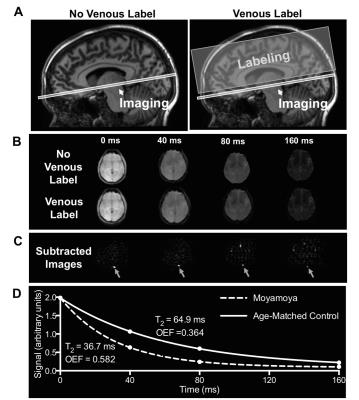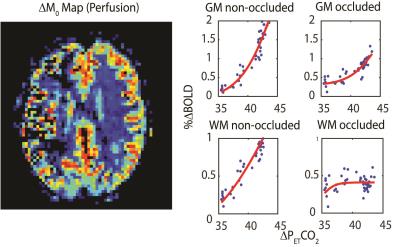Monday, 24 April 2017
| Room 310 |
13:45 - 15:45 |
Moderators: Ian Marshall, Danny Wang |
Slack Channel: #s_neuro
Session Number: O06
13:45
 |
0142.
 |
4D Flow MRI for Assessment of Venous Pressure in Dural Arteriovenous Fistulas 
Leonardo Rivera Rivera, Zachary Clark, Kevin Johnson, Patrick Turski, Oliver Wieben
Dural arteriovenous fistulas (DAVFs) are vascular malformations that can present aggressively. Venous hypertension is the pathophysiologic mechanism thought to be responsible for aggressive presentation. 4D flow MRI has demonstrated success generating pressure maps from velocity data in vessels. In this work we measure relative pressure in the dural sinuses in DAVFs patients using 4D flow MRI. Results support the hypothesis that DAVFs result in venous hypertension which may be the mechanism ultimately leading to aggressive presentation. 4D flow MRI allows blood flow directionality assessment along the dural sinuses, which helps to detect retrograde flow and classify the severity of DAVFs.
|
13:57
|
0143.
 |
Enhanced detection of cerebral arterial system with USPIO-enhanced MRI 
Yulin Ge, Jean-Christophe Brisset, Saifeng Liu, E. Mark Haacke
Although small arterial system plays a key role in delivering oxygen and glucose to brain tissue, the in vivo detection is still challenging. Using a low dose of ultra-small-superparamagnetic-iron-oxide (USPIO) contrast agent, it will induce susceptibility contrast in the arterial blood, which enhances the small arteries visibility on susceptibility weighted imaging. This study has demonstrated its feasibility in human brain. Such technique has potential to unveil underlyingmicrovascular abnormalities in neurovascular diseases that cannot be done in vivo with any other conventional method in use today.
|
14:09
 |
0144.
 |
T2-relaxation-under-spin-tagging (TRUST) and Arterial Spin Labeling MRI elucidate discrepant hemo-metabolic mechanisms underlying elevated oxygen extraction fraction (OEF) in moyamoya and sickle cell anemia (SCA) patients 
Jennifer Watchmaker, Meher Juttukonda, Larry Davis, Allison Scott, Carlos Faraco, Melissa Gindville, Lori Jordan, Petrice Cogswell, Angela Jefferson, Howard Kirshner, Manus Donahue
T2-relaxation-under-spin-tagging (TRUST-MRI) was performed in patients with intracranial stenosis due to moyamoya for determination of whole-brain oxygen extraction fraction (OEF). Elevated OEF was observed in this group compared to controls. In15O PET studies in individuals with intracranial stenosis, it has been shown that OEF increases regionally when cerebral blood volume (CBV) is inadequate to maintain cerebral blood flow (CBF) over a normal range, and importantly that regionally elevated OEF and CBV may be prognostic for recurrent stroke risk. This work has motivated the development and application of TRUST-MRI for use in patients with intracranial stenosis at risk for stroke.
|
14:21
|
0145.
 |
4D MR Angiography with Pseudo-Continuous Arterial Spin Labelling Combined with CENTRA-Keyhole (4D-PACK): Visualization of Distal Cerebral Arteries in Moyamoya Disease 
Osamu Togao, Akio Hiwatashi, Makoto Obara, Koji Yamashita, Ryotaro Kamei, Hiroshi Honda
In the present study, we demonstrated the clinical utility of 4D-MR angiography with pCASL combined with CENTRA-keyhole (4D-PACK) in Moyamoya disease by comparing with a well-established pulsed ASL-based 4D-MRA called contrast inherent inflow enhanced multi-phase angiography (CINEMA). 4D-PACK provided higher CNRs than CINEMA in distal MCA branches in later phases indicating that 4D-PACK enables better visualizations of distal cerebral arteries supplied by collaterals vessels during a long transit time. This could be due to higher flow signal obtained with pCASL and less saturation effect after labeling. 4D-PACK can be a non-invasive clinical tool in assessing hemodynamics in Moyamoya disease.
|
14:33
|
0146.
 |
Probing the BOLD-CVR response to progressive hypercapnia in patients with uni-lateral carotid artery occlusions 
Alex Bhogal, Jeroen Siero, Hans Hoogduin, Peter Luijten, Jeroen Hendrikse, Jill De Vis
We examine the BOLD-CVR response to a progressively increasing vascular stimulus between individuals with carotid artery occlusions and healthy, age/gender-matched controls. Using this paradigm, we aim to understand finer-scale interactions between impaired versus healthy cerebral hemispheres at different vascular stimulus magnitudes.
|
14:45
 |
0147.
 |
Analysis of cerebrovascular watershed areas in patients with high-grade carotid artery stenosis using DSC-based time-to-peak maps - permission withheld
Vanessa Griese, Stephan Kaczmarz, Anne Kluge, Kim van de Ven, Michael Helle, Hendrik Kooijman-Kurfuerst, Claus Zimmer, Christian Sorg , Jens Göttler, Christine Preibisch
Internal carotid artery stenosis (ICAS) is one of the leading causes for thromboembolic and hemodynamic cerebral infarction. Here, we present data from an ongoing clinical MRI-study in patients with asymptomatic, high-grade ICAS and healthy controls. Our major aim was to establish a method to delineate individual watershed areas in patients and controls using MRI-based dynamic susceptibility contrast (DSC) time-to-peak (TTP) maps, also including the anatomical information of magnetic resonance angiography (MRA) to define individual vascular territories. Watershed areas were enlarged and shifted in many of the vascular territories of stenosed carotid arteries, being verified by ss-pCASL in a subgroup.
|
14:57
|
0148.
 |
Effective collateral circulation may related with better perfusion restoration after carotid endarterectomy (CEA): a pilot territory ASL (tASL) study 
Tian-ye Lin, Yue-lei Lv, Zhi-chao Lai, Hui You, Bo Hou, Bing Wu, Jian-xun Qu, Chang-wei Liu, Feng Feng
Flow territories normalization was observed in patients underwent carotid endarterectomy (CEA). To investigate whether collateral flow associated with the redistribution of blood we performed 3D ASL and tASL on 25 patients prior to (PRE) and after (POST) surgery. Collateral flow was read as the presence of arterial transit artifact (ATA) on 3D ASL images. Alteration of flow territories was determined by comparing the PRE and POST tASL images. Our study demonstrated that good collateral compensation shown in ASL was associated with normalization of tASL flow territories after CEA.
|
15:09
|
0149.
 |
One-sided hypoperfusion is associated with contralateral attention deficits in asymptomatic high-grade carotid stenosis patients. 
Jens Goettler, Stephan Kaczmarz, Rachel Nuttall, Vanessa Griese, Hendrik Kooijman, Michael Helle, Kim van de Ven, Claus Zimmer, Kathrin Finke, Christian Sorg, Christine Preibisch
Patients with clinically asymptomatic, high-grade internal carotid artery stenosis (ICAS) often show cognitive impairments, such as memory dysfunction and attention deficits. However, it is still unclear whether these symptoms are caused by potentially reversible cerebral hypoperfusion or rather by a general unchangeable vascular damage. Here, 17 patients with one-sided high-grade, asymptomatic ICAS and 26 age-matched healthy controls underwent an MRI scan, including pCASL to assess brain perfusion, and a computer-based visual attention test. Patients show distinct unilateral cerebral hypoperfusion being significantly associated with contralateral attention deficits. Data indicate that chronic cerebral hypoperfusion in high-grade ICAS impairs cognitive function.
|
15:21
 |
0150.
 |
Saccular intracranial aneurysm wall permeability and shear stress distribution: a further insight into rupture pathogenesis 
Xian Liu, Yu Chen, Haikun Qi, Peng Liu, Yunduo Li, Xiaole Wang, Le He, Qiang Zhang, Zhensen Chen, Rui Li, Youxiang Li, Chun Yuan, Huijun Chen
The purpose of this study is to explore the relationship between aneurysm wall permeability and the hemodynamic conditions of intracranial aneurysm (IA). The results showed that hot spot of IA wall permeability was spatially related with significantly lower wall shear stress magnitude and higher oscillatory shear index, which suggests the pathology of IA might be an interaction of both factors, and IA wall permeability could be a potential method for IA rupture risk assessment.
|
15:33
|
0151.
 |
Investigation of zero TE ASL MRA in the follow-up after endovascular treatment of intracranial aneurysm at 1.5T 
yan song , Peng Qi, Juan Huang, Sheng Jiao, Tan Guo, Min Chen, Daming Wang, Jing Zhang, Bing Wu, Zhe Luo
It is necessary to follow up the intracranial aneurysms treated with coil or/and stent for recanalization or remnant. TOF MRA, though performed well, is susceptible to metallic artifact and flow artifact. ASL MRA with zero TE acquisition has potential advantages. The purpose of this study was to evaluate the performance of ASL MRA by comparing with TOF MRA, using DSA as gold standard. It was demonstrated that ASL MRA featured significantly better consistency with DSA for aneurysm remnant diagnosis and led to superior image quality in the presence of intra-stent lumen as compared to TOF at 1.5T.
|
|












